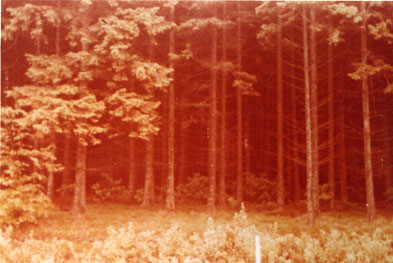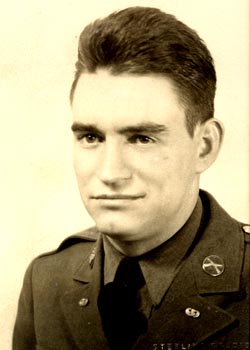MARK BANDO'S WEBSITE
Luzery Woods, Scene of the Woods Fight described in Don Burgett's book 'Seven Roads to Hell'
 In 1979, Don Burgett WW2 paratrooper/author, returned to the woods where his company engaged in a vicious, close-quarters fight near Luzery, Belgium in December, 1944. He snapped the photo above, showing where A/506th turned off the Bastogne-Houffalize road and entered to clear the Germans from the forest. When I returned with Don to this spot in 1998, we found that this entire section of trees had been harvested and the scene of the action has been forever lost. A short distance inside the trees shown above, was the small hole where a German killed John Bielski and Salome Alvarado, before he himself was killed as Alvarado went down. Don took another photo inside these dark woods, right at the spot where the action took place, but the photo came out too dark to successfully reproduce here.
In 1979, Don Burgett WW2 paratrooper/author, returned to the woods where his company engaged in a vicious, close-quarters fight near Luzery, Belgium in December, 1944. He snapped the photo above, showing where A/506th turned off the Bastogne-Houffalize road and entered to clear the Germans from the forest. When I returned with Don to this spot in 1998, we found that this entire section of trees had been harvested and the scene of the action has been forever lost. A short distance inside the trees shown above, was the small hole where a German killed John Bielski and Salome Alvarado, before he himself was killed as Alvarado went down. Don took another photo inside these dark woods, right at the spot where the action took place, but the photo came out too dark to successfully reproduce here.
In 1999, Don's book on Bastogne was published by Presidio Press and the action alluded to above is described in graphic detail, in Chapter 4 of that book. Photo courtesy Donald R. Burgett
THE MAN WITH NO NAME
 The concept of one exceptional warrior slaying many times his number and living to tell about it, was recognized long ago in Japanese tales of the Samurai. In movies, Japanese director Akira Kurosawa depicted such characters in films like "Yojimbo". Another popular theme was the self-serving antihero, who killed without apparent remorse. American filmakers first picked-up on these themes when "The Magnificent Seven" was made in the 1950's- a Western inspired by a Samurai movie: "The Seven Samurai". But American audiences really responded in a big way in 1965, when Clint Eastwood's first spaghetti western "A Fistful of Dollars"( inspired by 'Yojimbo'), depicted him as a loner-Antihero, who shot down multiple opponents in a single confrontation. This went against the traditional Western theme of a showdown between only two opponents, one on one, but audiences loved it. Surely in American history, there were exceptional warriors who had actually achieved such feats. I found such a real life 'Man With No Name' in Melton 'Tex'McMorries, WW2 paratrooper of G/501 PIR. Out of the 900 WW2 101st survivors I've interviewed, Tex was a standout. This was no B.S.; Tex was proficient, not only in his assigned job of machinegunner on the M1919A4 light machinegun (LMG), but was also skilled in all aspects of modern war, from patrolling to knife fighting. Tall, lanky, and part Apache, Tex was the living personification of the lean and mean characters portrayed by Clint Eastwood on film. A product of the windswept badlands of West Texas, McMorries grew up in the wide open praries, where quail hunting was occasionally interrupted by dodging rattlesnake strikes.
The concept of one exceptional warrior slaying many times his number and living to tell about it, was recognized long ago in Japanese tales of the Samurai. In movies, Japanese director Akira Kurosawa depicted such characters in films like "Yojimbo". Another popular theme was the self-serving antihero, who killed without apparent remorse. American filmakers first picked-up on these themes when "The Magnificent Seven" was made in the 1950's- a Western inspired by a Samurai movie: "The Seven Samurai". But American audiences really responded in a big way in 1965, when Clint Eastwood's first spaghetti western "A Fistful of Dollars"( inspired by 'Yojimbo'), depicted him as a loner-Antihero, who shot down multiple opponents in a single confrontation. This went against the traditional Western theme of a showdown between only two opponents, one on one, but audiences loved it. Surely in American history, there were exceptional warriors who had actually achieved such feats. I found such a real life 'Man With No Name' in Melton 'Tex'McMorries, WW2 paratrooper of G/501 PIR. Out of the 900 WW2 101st survivors I've interviewed, Tex was a standout. This was no B.S.; Tex was proficient, not only in his assigned job of machinegunner on the M1919A4 light machinegun (LMG), but was also skilled in all aspects of modern war, from patrolling to knife fighting. Tall, lanky, and part Apache, Tex was the living personification of the lean and mean characters portrayed by Clint Eastwood on film. A product of the windswept badlands of West Texas, McMorries grew up in the wide open praries, where quail hunting was occasionally interrupted by dodging rattlesnake strikes.
In his unauthorized combat diary during the Holland campaign , Tex wrote: "A bunch of the men got a little drunk, treated me rather rough, wanted me for Platoon Sgt. They said I could destroy the MGs, got through the lines, used the knife, while others talked about ways to do it...that I was the ace killer. Pretty good compliment, even if they were half drunk. One thing: no soldier can swagger, put up a false front. Combat classifies him in the eyes of all that observe. Perhaps a few are born for combat, some for officer, some for troop work. Among the officers, Sheridan and Wasco-the latter, Serwatka, Case, Baldwin. Case the smartest, Baldwin the most skilled, Serwatka, the ideal trooper."
During the Market-Garden operation alone, Tex McMorries accounted for about 100 German
deaths. He belonged to the '30 in one day' cult of 501st machinegunners, achieving that score with his LMG at Eerde and later up on the dike west of Arnhem. Even with the machinegun, these kills did not come easily. It was not a simple matter of 'mowing them down', as in the movies. Al Lisk of F/501 says: "I'm of the opinion that with a machinegun, you're going to get as many as you can get with the first burst, then after that, the enemy is taking cover and returning fire." And so it was at the Eerde fight on 24 September, 1944. The Germans attacked with tanks and infantry after an intense artillery preparation. Tex's machinegun accounted for 38 of the enemy and was instrumental in halting the attack. The tanks held back when they spotted a phony minefield, planted as a ruse by American troops before the battle. Tex wrote in his diary: "Germans made an all out attack-they are giving my position priority. They have thrown approximately 600 rounds of artillery within a 50 yard radius of my position. They have used tanks and many machineguns. I got 38 and wounded others. They are smart. Only once did I get two with the same burst, and they were stretcher bearers."
Tex was later made a machinegun instructor and wrote a treatise on this subject, entitled "Pointers for Combat Machinegunners" A quote from that document follows: "In training as well as in combat...a mental and physical analysis of the terrain must be made from every position, the range, the outstanding features of the terrain, blind spots (where possible, an alternate gun position prepared to cover said spots). The correct time to do this is at the first opportunity; there may be no second chance for this. Knowledge saves time. A fraction of a second frequently determines who will need replacements-the enemy or your unit. When engaged in combat with a modern and well-trained enemy, the familiar saying mow them down is mostly bunk. If the enemy presents this type of target, most any machinegunner can align the sights and pull the trigger. A trained enemy knows the rate of traverse of a machinegun and the attack is paced accordingly. A gunner will have one clear target only at a given instant. He may see more, but for all practical purposes they are not there, because of the wide traverse and the time element. As a general rule, these targets appear for two or three seconds only. When the gunner has to traverse five or six mills, this cuts his time to practically zero. The wide traverse also has the disadvantage of causing a higher percentage of misses due to over traversing and due to the speed required. The shortest way to increase the number of good targets is to increase the angle of fire. A gun pointing straight into the enemy lines has the greatest disadvantage, because of the traverse required to bring it on various targets. A gunner's tendency to fire at targets which
threaten him most directly is understandable. Nevertheless, in most cases it is a fatal mistake in regards to obtaining the highest efficiency of the LMG."
McMorries combined the sharp instincts of a Prizefighter with technical expertise acquired from Army training. He also once commented that "a smart sharpshooter will score more kills than a dumb expert."
 The photo above depicts ongoing training at the 101st Airborne's Combat Machinegunner School in 1945.photo courtesy of Bill Kennedy, A/506th.
The photo above depicts ongoing training at the 101st Airborne's Combat Machinegunner School in 1945.photo courtesy of Bill Kennedy, A/506th.
MORE MACHINEGUN LORE
As mentioned previously, Stanley 'Pappy'Green of F/501 achieved about 30 kills in one day on two seperate occasions in Normandy.
The first time was between Angoville and St Come du Mont, when German troops were changing positions en masse. Green caught them from the flank, as they passed by a gate/gap in a hedgerow.
In his book 'With Geronimo Across Europe', medic Richard O'Brien of G/501 described a humorous incident in Holland. A machinegunner of his company had set up his tripod-mounted LMG, pointed at the dike embankment near Heteren. It was broad daylight, and the gunner had started a fire and melted chocolate bars and marshmellows in a cooking pot-he was making Fudge on the front line. Glancing occasionally to his right as he stirred the mixture with his left hand, the gunner would fire bursts at Germans scaling the dike to rejoin their forces near the river. Although 'O'Bie' didn't know the gunner's name, it is believed that he was Frank 'Big
Dog'Serwatka.
Another gunner in
'G' company, and very skilled in Tex's estimation, was Bob'Granny'Baldwin. Lee Parrish saw Baldy behind his LMG also in Holland one day. The gun was pointed at a slope and retreating German troops were running up, broadside. Baldwin was
TALKING while firing, as if the Germans could hear him. i.e.:
"Well you dumb sonofabitch, you're not going to make it..." As
Baldwin spoke, Parrish could see Germans falling and sliding back
toward the bottom of the hillside.
Paratrooper Humor
 Because of the nature of their work, paratroopers have always embraced the macabre and gruesome in their humor, such as the lyrics to their Battle Hymn: "Gory, Gory, What a Helluva Way to Die". The interesting calling card shown above was created by Carl Cartledge of H&H S-2, 501 PIR, as a postwar afterthought.
Because of the nature of their work, paratroopers have always embraced the macabre and gruesome in their humor, such as the lyrics to their Battle Hymn: "Gory, Gory, What a Helluva Way to Die". The interesting calling card shown above was created by Carl Cartledge of H&H S-2, 501 PIR, as a postwar afterthought.







